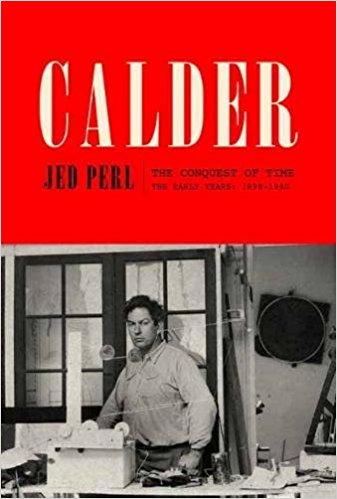Book Review: Calder
/Calder: The Conquest of Time – The Early Years: 1898-1940
by Jed Perl
Knopf, 2017
Jed Perl, the terrific writer whose mammoth new biography of American sculptor Alexander Calder, Calder: The Conquest of Time – The Early Years: 1898-1940, appears in bookstores this month, did an interview with his publisher about his subject. When asked how he came to write this, the first biography of Calder, he answered that the Calder Foundation had been disappointed with the nature and proposed direction of earlier biographical proposals. Their “great mission,” he said, “has been to reestablish Calder as an essential figure in the international avant-garde.” Perl agreed and was granted access to the Foundation's enormous tranche of Calder letters, papers, photos, sketches, and ephemera without which only a very thin and strained biography could possibly be written.
This is, of course, deeply troubling – not just because estates of well-known public figures shouldn’t be attempting to stage-manage the judgements of posterity by using a carrot-and-stick approach to their collections of invaluable historical documents, but also because such a close collusion between a biographer and the blood relatives of his subject, relatives with a “mission,” inevitably raises questions about compromise and impartiality. The Calder family opened its vaults to Perl – his big, expensive book is full of postcards, family photos, envelope doodles, art show programs, and the like, the effusion of little items that are just the kinds of things biographers tend to think significant.
Perl is a fine writer on art and artists, and in this big book he demonstrates also a tremendous effectiveness at describing the broader world into which Calder was born in 1898 and the eccentric nature of his family, which was full of artists and strong-willed iconoclasts, a family that adored their sternly handsome “Sandy” despite every reason he so often gave them to take a cool step back. Perl isn't quite a hagiographer, but he nevertheless works hard to make his readers like and admire Calder in these pages, following him through childhood, schooling, and into his burgeoning career as an avant-garde artist in Greenwich Village and the Left Bank, where his odd, whimsical mobiles (things he always called “objects” rather than “sculptures”) impressed critics and biddable buyers as … striking? Different? Innovative? “They're just toys, aren't they?” quipped a famous observer, perhaps less kindly than Perl interprets.
Readers are told that Calder “had a way of absorbing everything that was going on around him,” although those readers will search the whole length and breadth of the book's 600 pages for any hint that this was ever even slightly true, and they won't get many supporting indications even from Perl himself, whose descriptions of Calder feature not so much absorbing as refusing to absorb:
Was Sandy Calder open-minded? He was and he wasn't. At times he even appeared close-minded. He was determined to chart his own course. If that meant refusing to look to the left or to the right, so be it. He was by turns skeptical, inscrutable, good-humored, pigheaded, contrarian, and just plain goofy. None of it was bad. Somehow, it turned out to be his way of embracing all the revelations of modernity while remaining absolutely himself.
“At times he was even close-minded” is a characteristically generous assessment of a man who scarcely ever smiled, listened, or voluntarily learned anything, including his own craft. And Perl is equally generous about that craft itself, even though it often requires him to strain himself in ways that do neither himself nor that artwork any favors, as in his comments on Calder's 1939 mobile “Lobster Trap and Fish Tail,” which currently sits in the Museum of Modern Art:
Is the mobile somehow a meditation on the animal, vegetable, and mineral kingdoms? Does the fish tail stand for animal, the panoply of abstract leaves or petals for vegetable, and the trap made of metal for mineral? Who can say?
Who indeed. Perl works in these chapters to humanize his hero and present him in all his dimensions, and a second volume is promised, taking Calder's life from 1940 to his death in 1976. There's no doubt that these two volumes combined will form an incredible resource for all future Calder biographers, whether or not they have the enthusiastic support of the Calder Foundation. Fans of this artist's work have been waiting for volumes like these for decades, and they're the ones who'll most appreciate the portrait Perl creates.

